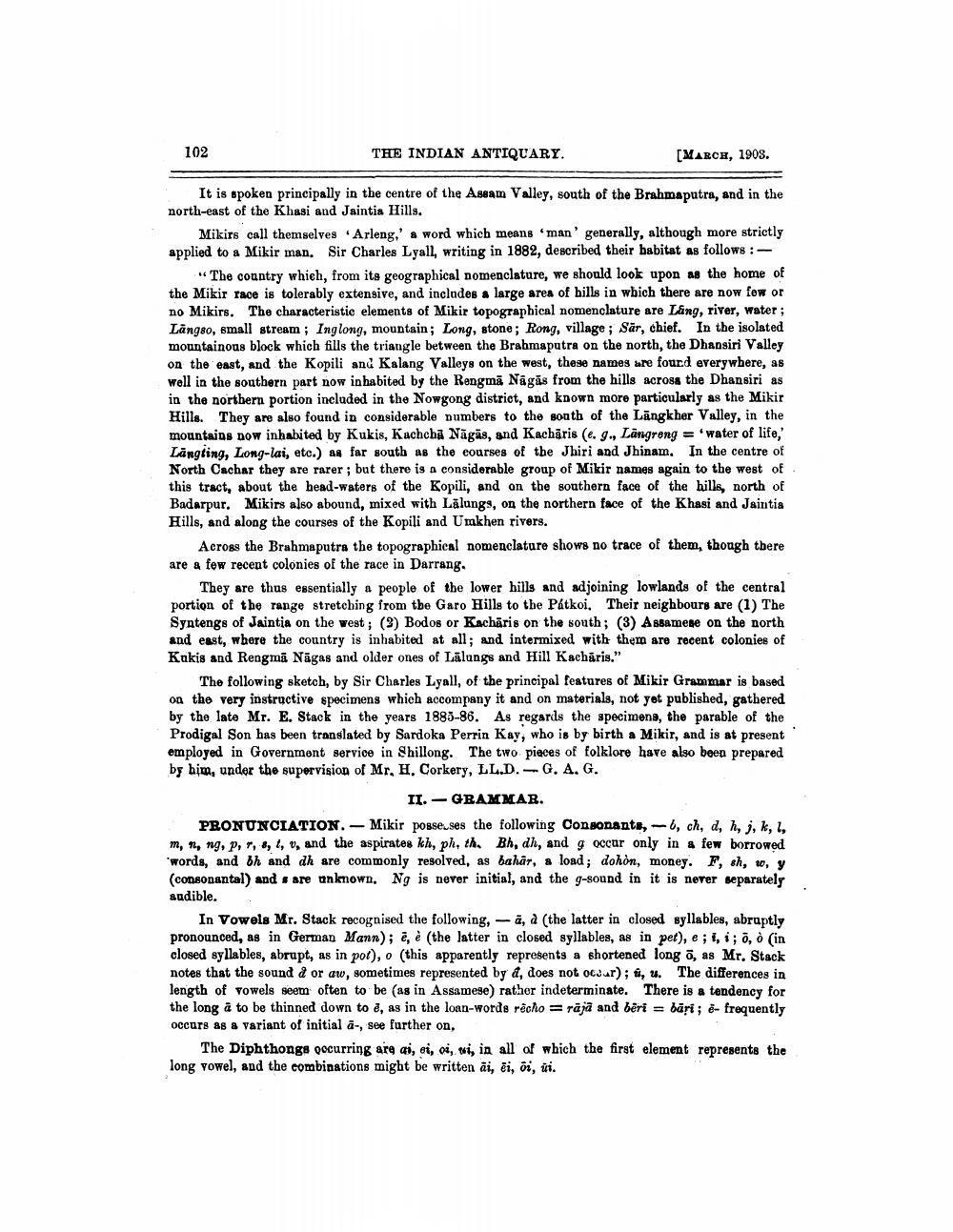________________
102
THE INDIAN ANTIQUARY.
[MARCH, 1903.
It is spoken principally in the centre of the Assam Valley, south of the Brahmaputra, and in the north-east of the Khasi and Jaintia Hills.
Mikirs call themselves · Arleng,' a word which means 'man' generally, although more strictly applied to a Mikir man. Sir Charles Lyall, writing in 1882, described their habitat as follows:
"The country which, from its geographical nomenclature, we should look upon as the home of the Mikir race is tolerably extensive, and includes a large area of hills in wbich there are now few or no Mikirs. The characteristic elements of Mikir topographical nomenclature are Lang, river, water; Langso, small stream ; Inglong, mountain; Long, stone; Rong, village ; Sär, chief. In the isolated mountainous block which fills the triangle between the Brahmaputra on the north, the Dhansiri Valley on the east, and the Kopili and Kalang Valleys on the west, these names are fourd everywhere, as well in the southern part now inhabited by the Rengma Nagás from the hills across the Dhansiri as in the northern portion included in the Nowgong district, and known more particularly as the Mikir Hills. They are also found in considerable numbers to the south of the Längkher Valley, in the mountains now inhabited by Kukis, Kachcha Nāgās, and Kachāris (e. g., Langreng = water of life, Langting, Long-lai, etc.) as far south as the courses of the Jhiri and Jhinam. In the centre of North Cachar they are rarer; but there is a considerable group of Mikir names again to the west of this tract, about the head-waters of the Kopili, and on the southern face of the hills, north of Badarpur. Mikirs also abound, mixed with Lālungs, on the northern face of the Khasi and Jaintia Hills, and along the courses of the Kopili and Umkhen rivers.
Across the Brahmaputra the topographical nomenclature shows no trace of them, though there are a few recent colonies of the race in Darrang.
They are thus essentially a people of the lower hills and adjoining lowlands of the central portion of the range stretching from the Garo Hills to the Patkoi. Their neighbours are (1) The Syntengs of Jaintia on the west ; (3) Bodos or Kachäris on the south; (3) Assamese on the north and east, where the country is inhabited at all; and intermixed with them are recent colonies of Kukis and Rengmā Nāgas and older ones of Lālungs and Hill Kachåris."
The following sketch, by Sir Charles Lyall, of the principal features of Mikir Grammar is based on the very instructive specimens which accompany it and on materials, not yet published, gathered by the late Mr. E. Stack in the years 1885-86. As regards the specimens, the parable of the Prodigal Son has been translated by Sardoka Perrin Kay, who is by birth a Mikir, and is at present employed in Government service in Shillong. The two pieces of folklore have also been prepared by him, under the supervision of Mr. H. Corkery, LL.D.-G. A. G.
II. - GRAMMAR. PRONUNCIATION. - Mikir posseuses the following Consonants, b, ch, d, h, j, k, l, m, n, ng, p, 7, 6, 1, v, and the aspirates kh, ph, th. Bh, dh, and g occur only in a few borrowed words, and bh and dh are commonly resolved, as bahar, a load; dohòn, money. F, sh, w, y (consonantal) and are unknown. Ng is never initial, and the g-sound in it is never separately audible.
In Vowels Mr. Stack recognised the following, -a, a (the latter in closed syllables, abraptly pronounced, as in German Mann); e, è (the latter in closed syllables, as in pet), e ; i, i; 0, ò (in closed syllables, abrupt, as in pot), o (this apparently represents a shortened long Ō, as Mr. Stack notes that the sound & or aw, sometimes represented by d, does not occur); 4, U. The differences in length of vowels seem often to be (as in Assamese) rather indeterminate. There is a tendency for the long å to be thinned down to e, as in the loan-words rècho = rājā and bēri = bāri ; e-frequently occurs as a variant of initial a-, see further on,
The Diphthonge Qocurring are ai, oi, oi, si, in all of which the first element represents the long vowel, and the combinations might be written ai, ei, oi, üi.




